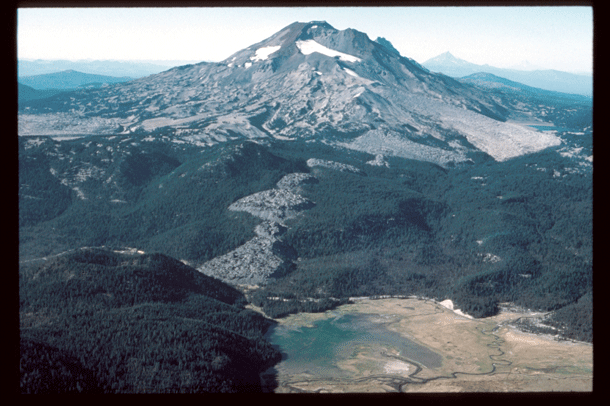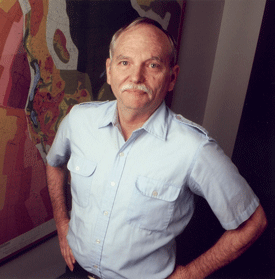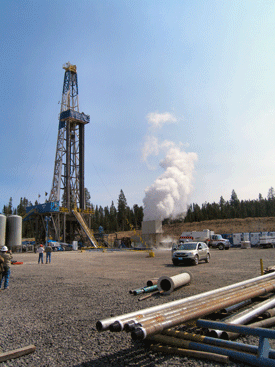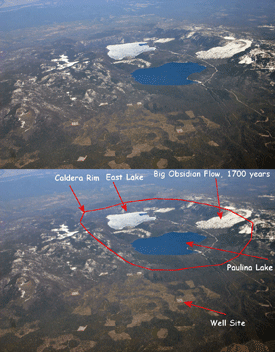Tapping Volcanoes for Energy
Air Date: Week of October 12, 2012

Geothermal energy from the Newburry Volcano in Oregon has potential to power millions of homes in the state. (USGS)
Scientists are exploring new technologies to harness the power of dormant volcanoes for geothermal energy. David Blackwell, an earth sciences professor at Southern Methodist University, tells host Steve Curwood that volcanoes could power millions of homes.
Transcript
CURWOOD: Well, the problems associated with many forms of energy are giving a boost to novel developments - including enhanced geothermal power. The US Bureau of Land Management has just given permission to tap a volcano in the Cascade mountain range in Oregon. The company Alta Rock Energy will drill into the Newbury volcano - that's been dormant for about 1600 years. David Blackwell is an Earth Sciences professor at Southern Methodist University in Dallas Texas, and a technical adviser on this project.
BLACKWELL: There’s a lot of very hot rocks associated with this volcano, so what will happen is the wells will have to be drilled and then a crack will have to be created between two wells that allows water to be pumped down one well and extracted through the other well after it’s heated up by running through the rock and then the hot water will be separated into steam and run through a turbine to the surface. The water that is produced from that well will be re-injected back into that first well and the cycle just continues.

Newburry Volcano (USGS)
CURWOOD: How hot is it down there?
BLACKWELL: It’s about 600 degrees Fahrenheit, so it’s quite warm.
CURWOOD: Now, how safe is this? I mean, drilling cracks into rocks in an area that’s inherently unstable… it seems like risky business. It kind of sounds like hydraulic fracturing to get natural gas.

David D. Blackwell
BLACKWELL: The process is very similar to the fracturing that they use to get the gas shales. But, in particular, with geothermal, there’s been a number of high-level studies to determine how to do this in the best, safest way, and how to monitor it to make sure the process doesn’t cause some kind of a problem.
CURWOOD: Now, I understand that the Newbury volcano is on Bureau of Land Management land, that’s federal land, and the Bureau has now given the green light to start drilling these wells. So what might be the danger to wildlife in the area?
BLACKWELL: The actual site of the well is in a clear-cut section, so this is not an area that is extensively used by the wildlife.
CURWOOD: And how much infrastructure is involved?
BLACKWELL: Very little. In fact, on the drill pad, which occupies, I think, about five acres, and all of the equipment will be on that pad. There’s a road, but the roads are already built because of the timbering - there’s extensive timbering on this side of the volcano.

The original drilling of the well that will be stimulated by AltaRock when it was drilled in 2008 by Davenport Energy and was being tested. There is a wisp of steam coming from the well in the separator to the right of the well. The white truck is preparing to run an instrument down the well to measure the temperature.
CURWOOD: So what’s the potential here? How much energy do you expect to get from the wells at the Newbury Volcano when it’s up and running?
BLACKWELL: We estimate that there’s potentially about 2,000 megawatts of power that could be developed. And that’s enough to basically run a city of a million people.
CURWOOD: What’s the potential for hot-rock energy for the United States?
BLACKWELL: The potential is immense, because once we can develop the technology, then we can make accessible areas which were not previously utilizable from geothermal power. So this could really increase, by orders of magnitude, the amount of geothermal power that the United States could develop. Right now there’s on the order of 3,000 megawatts, but it could easily go to 10 to 20 times that number.
CURWOOD: So, professor, how benign is this form of energy compared to the other choices we have out there? I think of burning coal, I think of nuclear power, I think of solar and wind.
BLACKWELL: Well, compared to solar and wind, geothermal is considered baseload. So, geothermal can operate 24 hours a day, 365 days a year, whereas both solar and wind are very intermittent, so they require other types of power to supplement them when the sun isn’t shining or the wind isn’t blowing. Compared to coal, geothermal is extremely clean, there are no emissions. The technology would be somewhat similar to the shale gas. But of course, again, burning gas generates CO2, but not nearly as much, it’s not nearly as polluting as coal.

Newberry caldera
CURWOOD: And compared to nuclear?
BLACKWELL: In nuclear, one has to look at the whole sequence of power source, from the mining, which generates pollution, because you’re opening up the ground which has radioactive materials, potentially subjecting that to groundwater, you’re refining it, but then when you’ve spent the fuel… we still don’t know what we’re doing with all of this waste fuel. So nuclear has a whole series of very complicated problems that have to be dealt with.
CURWOOD: This enhanced geothermal system sounds too good to be true! No pollution, all the steam you could need - you could power millions of homes with it… what’s the catch?
BLACKWELL: The catches are two: one we haven’t done it, and two it’s going to be probably a little bit more expensive than most of the other sources, with perhaps the exception of nuclear. But that’s why it’s important for there to be some support for the research of this type, because we need to find out if this is a source which we can develop, because it can have a very, very significant impact on a lot of factors dealing with energy in the United States.
CURWOOD: David Blackwell is a Senior Professor of Earth Sciences at Southern Methodist University. Thank you so much, sir.
BLACKWELL: Thank you!
Links
Living on Earth wants to hear from you!
Living on Earth
62 Calef Highway, Suite 212
Lee, NH 03861
Telephone: 617-287-4121
E-mail: comments@loe.org
Newsletter [Click here]
Donate to Living on Earth!
Living on Earth is an independent media program and relies entirely on contributions from listeners and institutions supporting public service. Please donate now to preserve an independent environmental voice.
NewsletterLiving on Earth offers a weekly delivery of the show's rundown to your mailbox. Sign up for our newsletter today!
 Sailors For The Sea: Be the change you want to sea.
Sailors For The Sea: Be the change you want to sea.
 The Grantham Foundation for the Protection of the Environment: Committed to protecting and improving the health of the global environment.
The Grantham Foundation for the Protection of the Environment: Committed to protecting and improving the health of the global environment.
 Contribute to Living on Earth and receive, as our gift to you, an archival print of one of Mark Seth Lender's extraordinary wildlife photographs. Follow the link to see Mark's current collection of photographs.
Contribute to Living on Earth and receive, as our gift to you, an archival print of one of Mark Seth Lender's extraordinary wildlife photographs. Follow the link to see Mark's current collection of photographs.
 Buy a signed copy of Mark Seth Lender's book Smeagull the Seagull & support Living on Earth
Buy a signed copy of Mark Seth Lender's book Smeagull the Seagull & support Living on Earth

